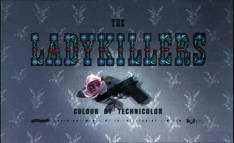 The Ladykillers The Ladykillers |
I’ve been a big fan of The Ladykillers for a long time. My initial interest in the film was because Peter Sellers and Alec Guinness were in it, so I eventually tracked it down many years ago on late-night television. And it’s true that Guinness is terrific as Professor Marcus, and Sellers, in his first feature, showed a lot of promise – even if he was still a bit inexperienced.
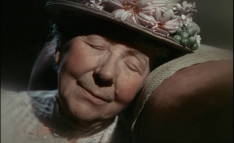 Mrs Wilberforce takes a nap – maybe for good? |
But what I didn’t expect, when I first saw it, was to be so impressed with the whole cast – Herbert Lom, Cecil Parker, Danny Green, and most of all Katie Johnson as Mrs Wilberforce. This little lady, who was seventy-seven at the time, gives a quiet and almost minimalist performance that gently but firmly dominates the film, despite (or because of?) the fact that she is surrounded by the relatively over-the-top antics of the male cast. She is perfect, and this is a nearly perfect film.
I recently rediscovered and rewatched the film thanks to three things: Kareena buying me the DVD of the film (what an amazing new transfer compared to the versions I have seen!); news of a recent remake (the trailer makes it look like it could be rather bad, but if it leads people to the original, then it’s a good thing); and stumbling across a great web page that compares the locations in the film to how they look now (I’ve always found that sort of thing interesting). Here’s a review that contains no spoilers for the second half of the film.
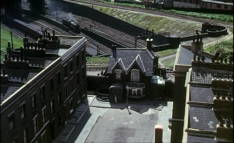 Mrs Wilberforce’s odd house |
The film begins with a shot of Mrs Wilberforce’s house – itself a character in the film. It’s an odd little building, with its walls and doors all at odd angles due to the bombing during World War Two, so none of the pictures hang straight and the plumbing doesn’t work properly. When the rest of the crooks move in they dub Mrs Wilberforce “Mrs Lopsided”. Situated right on top of a railway tunnel, it is perched at the end of its street as an odd anachronism from the past – much like its owner.
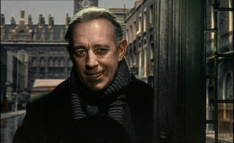 “I understand you have rooms to let.” |
Into Mrs Wilberforce’s ordered but lonely life comes a self-described criminal master-brain calling himself Professor Marcus, played by Alec Guinness wearing a long scarf, an expanded cardigan, and a startling set of false teeth. Professor Marcus rents one of Mrs Wilberforce’s rooms, and soon after follow the rest of the criminal gang: the cowardly Major Courtney (Cecil Parker in fine form), the slow but strong One-Round (Danny Green), the nervous Louis (Herbert Lom in one of his best), and the teddy boy gangster Harry (Peter Sellers in his first major feature film). Being a dark comedy character piece, there isn’t a lot of time to get to know these hopeless crooks in any well-rounded way, but they are sketched really well and have become memorable characters.
THE GANG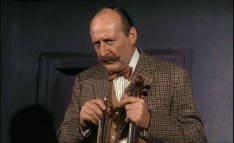 Major Courtney  One Round  Louis 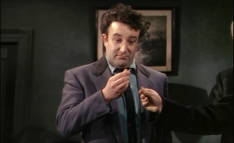 Harry |
Professor Marcus’ brilliant plan is to steal money from an armoured van and fool the police into thinking they have taken the loot out by train, when in fact they have tricked the innocent and above-suspicion Mrs Wilberforce into picking the stolen cash up from the station and bringing it to her home.
 “You’re the cellist Mr Lawson.” 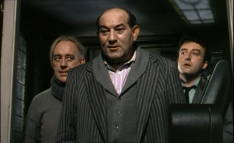 “Uh… I’m the…” 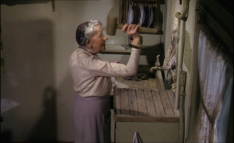 Mrs Wilberforce gives her plumbing some coaxing 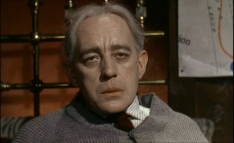 “Only the plan is important. My plan!” |
The team plan for their heist while fooling Mrs Wilberforce into thinking they are actually an amateur string quintet practicing in Professor Marcus’ room (using a record player to complete the illusion). Several charming scenes in the first half introduce the characters to us – these aren’t fully developed characters of course, but they are more than just two-dimensional stereotypes, the script and the actors really do bring these caricatures to life.
The men try to stay sane while cooped up in the small room, constantly having to place their string instruments into playing position whenever Mrs Wilberforce comes up to offer them tea, which is quite often. There’s a cute scene when one of her parrots escapes from its cage and the bungling crooks try to help capture it, destroying a chair and a section of guttering in the process. One bit that still amuses me is when One-Round has both feet stuck through the seat of a chair and is hopping around like a man trying to pull his pants up – when Mrs Wilberforce enters the room and sees this she gives a little “Ooh!” and quickly leaves, as if her modesty was offended by the sight.
These small but well constructed scenes underscore how much cinema has changed since 1955. There’s just no way a film like this will ever be made again, with its apparently unambitios scenes set in small rooms. These are scenes without any gags as such, they’re more like little character studies, though nothing too deep. It’s not just that the film was made on a shoestring budget that gives it this quality, as I doubt even a similarly low-budget indie film would have much success if it took a similar approach. If this story was made now the gags would be bigger and louder, and the heist would be for a much larger sum of money and be more dangerous (we shall see if I’m right when the remake comes out). In 1955 it was okay to tell a little story about small-time crooks, though for the time I’ll grant that the plot turns rather dark in the second half.
When the big day comes for the heist not everything goes according to plan, of course, and the meddling Mrs Wilberforce’s interest in the welfare of a horse nearly brings everything undone, but eventually the money arrives at the lopsided Wilberforce house, and all seems well as the crooks count their cash.
Of course, the film isn’t really about the heist at all, that’s just the elaborate set up, it’s about what happens afterwards. Mrs Wilberforce eventually discovers what the men have done, and how they have used her as part of the crime. Her softly-spoken yet outraged reaction is priceless, as if she has discovered young boys peeking into a girl’s changeroom. And, of course, these hardened criminals act just like young boys caught in the act – sheepish and apologetic, allowing Mrs Wilberforce to scold them and lock away their money. Eventually they realise they have to either convince Mrs Wilberforce to “stay buttoned up” or else kill her. But which of them will do it? The little Mrs Wilberforce is almost a force of nature – can anyone actually bring themselves to kill her? See the film yourself to find out.
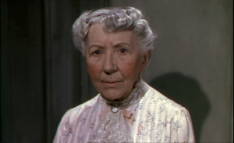 Mrs Wilberforce is shocked |
The look of the film is unique – it’s one of the first colour Ealing Studios films (and one of their last comedies I believe). Although this new DVD transfer is terrific, the colours are unavoidably a bit muddy and unconvincing (this is still really early colour), and the telecine colourist has wisely avoided trying to correct the image so that the colour and contrast are more in keeping with what we would expect today (even supposing that such a correction was possible).
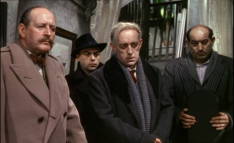 “Embarassing, and humiliating.” |
This gives the film an oddly garish quality, with bright reds and greens that contrast with the dark-comedy subject matter of death and murder. Also, the telecine seems cropped above and below compared to the TV versions I’ve seen, though this could be due to the TV versions being inaccurately taken from the full aperture print rather than what was seen in cinemas – since the film was released thirteen years before I was born, I’m going to have to trust CanalPlus on this one. Still, compared to the TV versions I’ve seen the film has never looked or sounded better.
See the original The Ladykillers before you see the remake – to give you a point of comparison. It’s not just many of the streets in the film that have vanished or been transformed since 1955, so has this style of filmmaking. The Ladykillers is highly recommended for those that don’t need their comedies filled with explosions.
|
THE GOOD |
THE BAD |
| Great script Great performances A 77 year-old steals the show |
The telecine is amazing but raises questions No extras to speak of |
|
THE OPINION: |
9.5 |
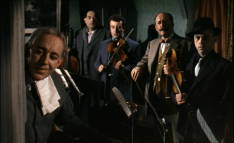 “Yes Mrs Wilberforce?” |
 Louis presses Professor Marcus’ buttons |
 “Shall I be Mother?” |
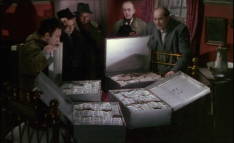 “How ’bout dat, eh? How ’bout dat.” |
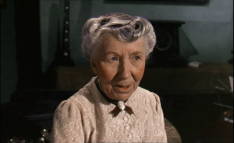 Mrs Wilberforce remembers her twenty-first birthday |
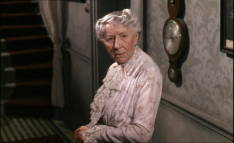 Mrs Wilberforce starts to piece it all together |
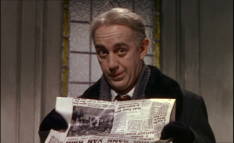 Professor Marcus caught red handed |
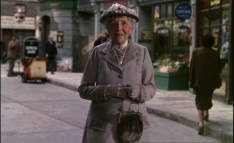 The indominatable Mrs Wilberforce |
What a wonderful summation and critical review of this marvelously, unique, inimitable and once in a lifetime film that still takes my breath away after all these years of having known its many felicities. The understatement of the year has to be the writer’s remark that this kind of film could never be made today. No kidding, Sherlock.
Best wishes for many more transcendental experiences in cinema. Try Ingmar Bergman for one.
Thanks for your comments… I think. 🙂
As the world’s biggest fan of The Ladykillers (do you know it’s coming to London, to the West End?) – I used to visit Professor Marcus when he was incarcerated – I must say your litle film summary is amazing! Thank you!
It is a wonderful film, isn’t it?
Regards,
Chelsea x